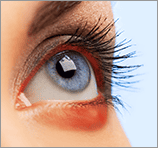A chalazion and a stye look very similar as lumps in or along the edge of the eyelid, but they are actually caused by different issues. A stye, which is typically redder in color than a chalazion, is caused by a bacterial infection in the root (follicle) of an eyelash. A chalazion occurs when a meibomian gland (an oil-producing gland within the eyelid) becomes enlarged and the gland becomes clogged with oil.
Although chalazia (plural for chalazion) are usually larger than styes, they are typically not painful. A stye, however, can feel tender and cause some light pain. A stye usually begins as a red bump that looks like a pimple and as it grows, the eyelid becomes swollen and the eye may water. Typically after 3 days, the stye breaks open and drains. After about a week, the stye should be healed.
A chalazion starts as a firm lump under the skin of the eyelid and usually grows more slowly than styes. The swelling may spread to the area surrounding the eye and if it gets large enough, it may affect vision. Without treatment, chalazia could go away in 3 months, but also could remain for 18 months if very large.
For both a stye and a chalazion, the initial treatment is heat for ten minutes, four times a day for two days. Using ½ cup of uncooked dry rice in a cotton sock, heated in a microwave for 30 seconds, held over the closed affected eye is a more effective way of heating than using a hot wash cloth. If the issue is not resolved within two days, especially if it’s a chalazion, it will need intense antibiotic/anti-inflammatory treatment to kill the infection. Chalazia will form scar tissue in the cartilage plate within the first five days and often times the lump can stay for months, even a year. Once scar tissue forms, the only treatment, other than extreme patience, is to cut out the scar tissue, so it is much better to treat early if you don’t want a minor office surgery.
It’s important to contact your ophthalmologist and try to begin effective antibiotic and anti-inflammatory treatment by day 3 if you have a growth or swelling of any kind on your eye or eyelids.
Sources:
https://www.webmd.com/eye-health/tc/styes-and-chalazia-topic-overview
https://www.geteyesmart.org/eyesmart/diseases/chalazion-stye/index.cfm
Photo Credit: https://www.stye.com/about-styes

